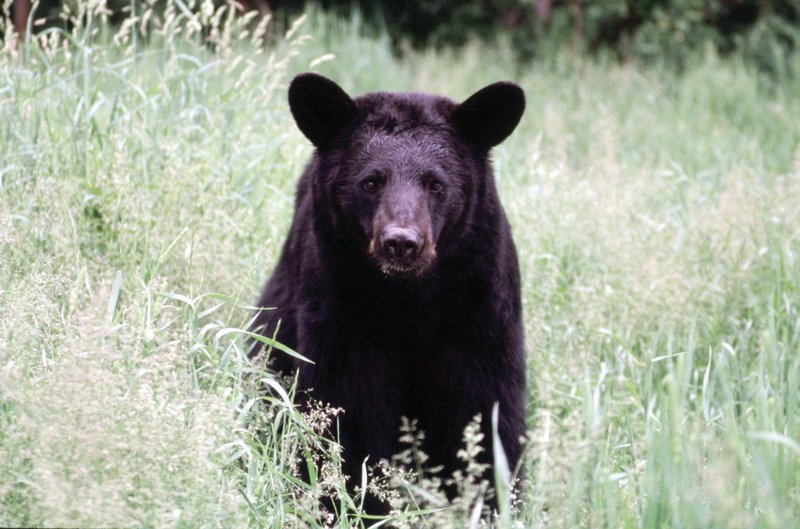Once while I was shooting photos on a Nebraska wildlife refuge, a half-ton bull bison tried to stomp me into the ground.
Years ago, I almost drowned when a trotline hook pierced my hand and the line pulled me from my boat.
One dark night during my short career as a law enforcement officer, I was ambushed by a drug dealer who beat me senseless in an alleyway.
These events were horribly frightening. I never will forget them. But none was as terrifying as being charged by an Arkansas black bear.
The attack
She came out of nowhere, galloped up an embankment and stopped just inches from me. Her jaws popped loudly. Her teeth were bared. I could feel her hot breath on my flushed cheeks. As I gazed into her maw, I wondered if she would kill me.
Panic seized me. My legs became jelly. My mind whirled. What should I do? I wondered. I knew I couldn’t outrun a bear.
I shut my eyes and remained perfectly still. Please, God, make her go away, I thought.
This happened during a fishing trip on Arkansas’ White River. Three friends — Cliff Shelby of Flippin, Alex Hinson of Paron and Bill Peace of Jonesboro — were with me. We had been fishing and were motoring upstream back to camp. While floating downstream, we saw several black bears, but each was spooky and quickly darted from sight in the riverside brush. Cliff commented he would like to photograph one of the bruins if we had an opportunity.
“There’s one now,” said Bill, who was at the helm. He swung the johnboat toward a sow and cub on a sand embankment. At our approach, however, the bears raced away.
I suggested all was not lost. We could photograph the bears’ tracks in the sand. Bill beached the boat and allowed the rest of us to disembark.
I was walking with my head down, looking for tracks, when the bear charged from her hiding place in a band of trees and brush. She wasn’t very large for a black bear — 200 pounds perhaps. But she frightened me more than anything has ever frightened me. Before the attack, I had no idea she was still nearby. Her loud, crashing assault was totally unexpected.
Much to my relief, when I opened one eye, the bear was gone.
Cliff and Alex witnessed the bear’s onslaught from a distance. They were headed my direction when the sow came at me a second time. She rushed toward me, popped her jaws a few more times and retreated once again. This time I ran.
Alex was shouting. There are two cubs, he said, not just one. I could hear one squalling from a treetop. The other remained silent, but I could see it in a tree as well. We were between the two cubs, with the mad mama bear hidden in the brush.
To say we beat a hasty retreat is somewhat misleading. Bill had already paddled the boat many yards from the bank, claiming the current was pulling him out. Yet somehow, Cliff, Alex and I covered those few yards without getting wet. You never know you can run on water until you must.
Bad encounter?
People who hear this story usually believe I had a bad encounter with a bear. That evening, as I recounted the story of the bear’s charge over and over again to my friends, I thought I had, too. Looking back on it now, though, I realize this wasn’t a bad encounter. The bear never touched me, although she easily could have. I’m fat and slow — no match for black bears, which are fat and fast.
What happened that day occurred because I used bad judgment. I inadvertently placed myself and my friends between a sow bear and her cubs — not a good place to be. The sow reacted as nature programmed her to, and the encounter ended as it should. We left the bear’s cubs alone, which is all she wanted. And the three bears, as far as I know, lived happily ever after.
Bear State bruins
Until the 1923 General Assembly changed its name to “The Wonder State,” Arkansas was known as “The Bear State.” At one time, experts have said, there were tens of thousands of black bears here. Bears were an important resource to early Arkansans. Indians and settlers used the bears’ skins for robes, and the meat and fat for food. Hunters killed thousands each year during the 1800s.
Unfortunately, indiscriminate killing and habitat reductions led to the demise of Arkansas’ bears. By the late 1940s, only 40 to 50 remained in the entire state.
Between 1959 and 1967, the Arkansas Game and Fish Commission undertook the largest bear-restoration effort ever conducted. Two-hundred-fifty-four black bears from Canada and Minnesota were released in The Natural State’s mountain forests during that time. Transplants were successful; the population increased dramatically. By 1980, the commission was able to reopen bear-hunting season after a 53-year hiatus. Hunts have been held each year since.
Today, between 3,000 and 4,000 black bears live in Arkansas, and most residents are happy these bruins once again roam our forests. Yet occasionally, people have bad encounters with the animals. A few years ago, an Arkansas man was terribly mauled when he and his dog startled a bear. Sometimes bears destroy beehives or scatter trash or break into homes looking for food. These are not good things, but they are inevitable in a world where man and wildlife must co-exist.
My own up-close experience with a bear was memorable, exciting, frightening and a thousand other things. But it was not bad. If you’re a hunter like me, perhaps it is good now and then to stand in the presence of a superior predator, knowing that you are, for once, a potential prey species. A little hackle-raising humility can make you a better sportsman.
